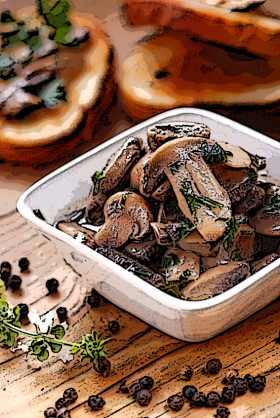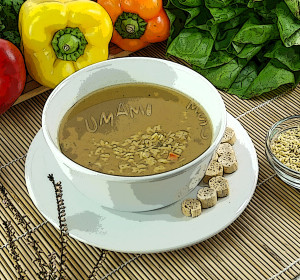The Umami Tsunami.
Chapter Eight, Part Three.
One + One = Three (The Synergy Of Umami).
 The subtle, savory fifth taste known as umami was first identified by Japanese scientist Kikunae Ikeda in 1907. In researching umami he discovered that it was linked with the amino acid glutamate and his investigations led to the development of monosodium glutamate (MSG) as a flavor enhancer. I could feed you lots of material about the development of umami-rich MSG but you would just be hungry for more in an hour.
The subtle, savory fifth taste known as umami was first identified by Japanese scientist Kikunae Ikeda in 1907. In researching umami he discovered that it was linked with the amino acid glutamate and his investigations led to the development of monosodium glutamate (MSG) as a flavor enhancer. I could feed you lots of material about the development of umami-rich MSG but you would just be hungry for more in an hour.
The umami tsunami began in earnest six years after Ikeda’s discovery when his follower Shintaro Kodama learned that glutamate, when combined with nucleotides, creates a dramatic flavor enhancing synergy. For example, when meat (high in the nucleotide inosinate) is combined with glutamate-rich foods like tomatoes or cheese, a significant umami boost is created. To understand the power of this synergy, think of the flattering outcome when you add cheese to a hamburger or braciola to tomato sauce (or as we say in New Jersey, you put the bruh-johl in the gravy).
In the years that followed Kodama’s discovery, researchers identified scores of additional sources for umami, and by 1998 researchers Shizuko Yamaguchi and Kumiko Ninomiya identified 39 umami-triggering substances including succinic acid which is found in wine.
For those of you who might believe umami is more mythology than biology, the real breakthrough came in 2000 when researchers at the University of Miami discovered a taste bud in a laboratory mouse that reacted to an amino acid molecule. When the taste receptor was exposed to the umami-generating amino acid, an electrical signal was sent to the brain, simultaneously satisfying the mouse and skeptical scientists around the world. It also explained why so many mice frequent Chinese restaurants.
We now know umami can be found in any number of foods, including fish, poultry, meat, fruits, vegetables, cheeses, mushrooms and wine. Chefs who routinely combine ingredients to create better flavors understand the synergy of umami even if they don’t know the chemistry behind their efforts. This synergy was explained by researchers Yamaguchi and Ninomiya:
The long tradition of using combinations of foods to make soups and stocks might conceivably have been to achieve a combination of glutamate and 5’-ribonucleotides, which would have greatly enhanced the umami taste. Thus, it is common knowledge in Japan that seaweed and bonito make tastier soups, in France that meat (or fish) and vegetables make more flavorful stocks, and in Italy that cheese or tomato cooked with seafood produces a tastier dish.¹
 It’s no surprise that many types of seafood are high in umami as it was a bowl of fish soup that triggered Ikeda’s search for umami in the first place. His soup was a combination of Kombu seaweed and dried Bonita tuna, a perfect storm of glutamate and nucleotides.
It’s no surprise that many types of seafood are high in umami as it was a bowl of fish soup that triggered Ikeda’s search for umami in the first place. His soup was a combination of Kombu seaweed and dried Bonita tuna, a perfect storm of glutamate and nucleotides.
You can explore this synergy in your own kitchen as glutamate-packed tomato sauces are the perfect Petri dish for creating umami. Just add foods high in nucleotides and watch the umami multiply faster than Mariah Carey’s dress size. Nucleotide-rich foods include mushrooms, seed sprouts, sardines, mackerel, tuna, bonito and bonito flakes, ham, organ meats and aged beef.
Besides tomatoes, foods high in glutamate include dairy products (especially cheeses), grains (in particular wheat, barley and oats), certain beans (try pinto, soy, Lima, lentils), peanuts (including cashews, almonds and pistachios), and meats (lamb has the lowest glutamate, turkey the highest).
Certain processes such as slow cooking, ripening, fermentation, drying, curing, or aging amplify umami characteristics in food by breaking down complete proteins into smaller, umami generating amino acids. Our palates are quick to detect these simpler tastants so we get an instant feeling of satisfaction. And frankly, at the rate I’m ripening, fermenting and aging, every minute counts.
Beef prepared in a slowly simmered stew has more umami than beef cooked quickly. As tomatoes ripen they develop considerably more umami taste. The fermentation process contributes to the umami characteristics in soy sauce, Worcestershire sauce, Asian fish sauces, plus beer and wine. Drying, curing and aging significantly concentrates umami qualities in foods like mushrooms, ham, beef and cheese. Perhaps this explains why dried mushrooms are preferred by many chefs for preparing soups, why prosciutto is more flavorful than simple pork, or why some steaks and cheeses become tastier when aged.
Once your palate gets acclimated to umami you’ll be able to spot it in very old, earthy red wines such as Bordeaux or Barolo, or in ripe, creamy Chardonnays. Yeast is a potent umami host so umami is often recognizable in white wines that spend time in contact with the lees (dead yeast cells that settle to the bottom of the tank during fermentation) or in rich Champagnes that also undergo prolonged lees contact.
In an age when over-the-top cuisine is en vogue and adventurous diners are looking for  ever more powerful flavors, umami might best be described as “comfort food”. I know I’ve come to find comfort in its satisfying richness and you too may come to recognize and appreciate the savory taste of umami. You need only to follow my lead and experience it at the end of a fork – rather than at the end of a Kindle.
ever more powerful flavors, umami might best be described as “comfort food”. I know I’ve come to find comfort in its satisfying richness and you too may come to recognize and appreciate the savory taste of umami. You need only to follow my lead and experience it at the end of a fork – rather than at the end of a Kindle.
¹Yamaguchi, S. and Ninomiya, K. (2000) Umami and Food Palatability 1. In: The Use and Utility of Glutamates as Flavoring Agents in Food. The Journal of Nutrition, Vol. 30 no. 4 921























Ms. Carey’s dress size has to be classified as ooh-baby!